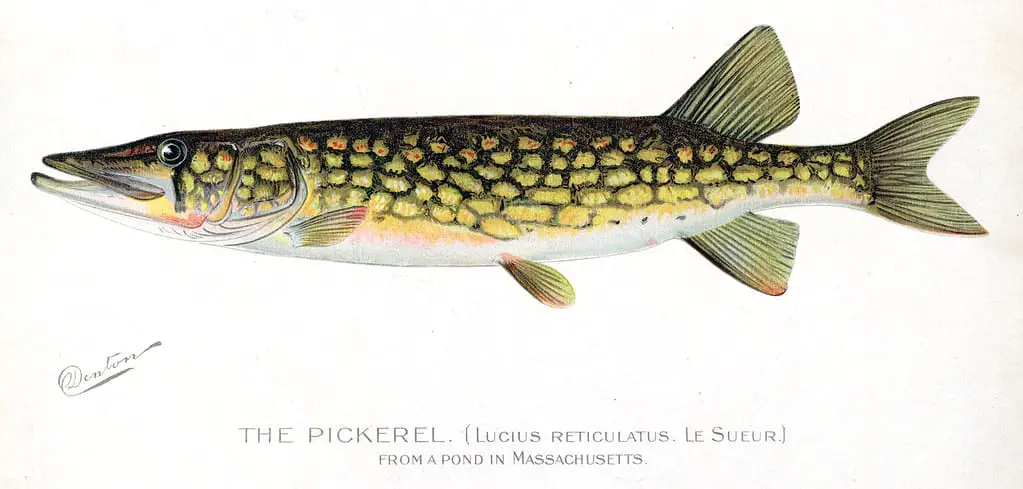Walleye and pickerel are confused due to similar appearances, but they belong to different families. Walleye, scientifically known as Sander vitreus, are prized game fish known for their large size and excellent taste, primarily found in freshwater habitats across North America. Pickerel, on the other hand, refer to several species within the Esox genus, such as the chain pickerel and the grass pickerel, known for their aggressive feeding habits and inhabiting similar freshwater ecosystems.
Key Takeaways
- Walleye and pickerel are freshwater fish with similar appearance and taste.
- Walleye have larger eyes and are more likely to be found in deeper, colder waters, while pickerel are found in warmer, shallower waters.
- “pickerel” is used interchangeably with “northern pike”, a different fish species.
Walleye vs Pickerel
Walleye is a freshwater fish native to North America, known for its delicious taste and large, sharp teeth. Pickerel is a species of fish in the pike family and ability to catch prey quickly. They are found in slow-moving bodies of water and have a dark green or olive colour, with a lighter belly and small, sharp teeth.

Walleye is a freshwater perciform fish found in Canada and the Northern United States. They belong to the pike family and are olive or gold in colour.
Pickerels, on the other hand, are freshwater fishes, more precisely known as Chain Pickerels. They, too, are found in Canada and the Northern United States. They have a rather greenish colour, on their sides.
Comparison Table
| Feature | Walleye | Pickerel |
|---|---|---|
| Family | Perch (Percidae) | Pike (Esocidae) |
| Body Shape | More slender, elongated body | More elongated and slender than pike, but stockier than walleye |
| Coloration | Olive or gold with a metallic sheen, vertical dark bars on back | Greenish-olive with vertical or horizontal dark spots or bars |
| Eyes | Large, glassy eyes with a white or yellow “walleye” on the lower edge | Smaller eyes with no distinctive markings |
| Dorsal Fin | Single, spiny dorsal fin located further back on the body | Single, spiny dorsal fin located closer to the mid-body |
| Tail Fin | Deeply forked tail with a white tip on the lower lobe (may be faint) | Shallowly forked tail, no white tip |
| Size | Larger, reaching 2-3 feet and up to 10-15 lbs | Smaller, reaching 1-2 feet and up to 5 lbs |
| Habitat | Clear, cool lakes and rivers | Lakes, rivers, and some brackish waters |
| Flavor | Mild, sweet flavor | Slightly gamier flavor |
What is Walleye?
Walleye, scientifically known as Sander vitreus, is a species of freshwater fish native to North America. It belongs to the Percidae family, which also includes yellow perch and sauger. Renowned among anglers for its sport fishing qualities and delectable flesh, the walleye is a prized catch in various freshwater bodies across the continent.
Physical Characteristics
- Appearance: Walleye are characterized by their sleek, elongated bodies with olive-green or brownish backs and brassy or golden sides. They have distinctive marble-like patterns along their flanks and a white belly. One of the most notable features is their large, glassy eyes, which appear to “glow” in low light conditions, giving them their name.
- Size: These fish range in size from 12 to 30 inches, although specimens exceeding 30 inches are not uncommon, especially in nutrient-rich waters. The weight of walleye varies greatly depending on their habitat and available food sources, with trophy specimens weighing over 10 pounds.
Natural Habitat and Distribution
- Habitat: Walleye thrive in a variety of freshwater environments, including large lakes, reservoirs, rivers, and some smaller inland lakes. They prefer cool, clean waters with moderate vegetation and ample prey species. Walleye inhabit deeper areas during the day and move to shallower waters at dawn and dusk to feed.
- Distribution: Native to North America, walleye are found throughout much of the continent, from the northern reaches of Canada to the central and eastern United States. They are particularly abundant in the Great Lakes region and the Mississippi River basin. Due to their popularity as game fish, walleye have been introduced to many other regions where they were not originally found.
Feeding Behavior
- Nocturnal Predators: Walleye are primarily nocturnal feeders, relying on their exceptional low-light vision to hunt effectively during dawn, dusk, and nighttime hours. Their large eyes, equipped with a layer of reflective cells called tapetum lucidum, enhance their ability to see in dim conditions.
- Prey Species: Walleye have diverse diets, feeding on a variety of aquatic organisms such as minnows, crayfish, insects, and smaller fish species. They are opportunistic predators, targeting whatever prey is most abundant and easily accessible in their habitat.
Importance to Anglers and Conservation
- Sport Fishing: Walleye are highly prized by anglers for their challenging fights and delicious flesh. Their popularity as a game fish has led to extensive management efforts to sustain healthy walleye populations in many freshwater ecosystems. Fishing for walleye can be both recreational and commercial, contributing significantly to local economies in regions where they are abundant.
- Conservation Concerns: Despite their widespread distribution, walleye populations face threats from habitat degradation, pollution, overfishing, and competition with invasive species. Conservation measures such as habitat restoration, stocking programs, and catch limits are crucial for ensuring the long-term sustainability of walleye fisheries.

What is Pickerel?
“Pickerel” is a common name used to refer to several species of freshwater fish belonging to the Esox genus, which also includes pike and muskellunge. These fish are known for their predatory behavior and are prized by anglers for their aggressive strikes and fighting ability. While confused with walleye due to similar appearances, pickerel species have distinct characteristics and habitats.
Common Species
- Chain Pickerel (Esox niger): Found primarily in the eastern United States, chain pickerel inhabit slow-moving waters such as swamps, ponds, and backwaters of streams. They are characterized by a chain-like pattern along their greenish backs and sides, with a lighter belly. Chain pickerel grow to lengths of 18 to 24 inches, although larger specimens are possible.
- Redfin Pickerel (Esox americanus americanus): Native to the southeastern United States, redfin pickerel prefer shallow, vegetated areas of streams, swamps, and ponds. They have distinctive red markings on their fins, which contrast with their olive-green bodies. Redfin pickerel are smaller than chain pickerel, averaging around 8 to 12 inches in length.
Physical Characteristics
- Appearance: Pickerel species have elongated, torpedo-shaped bodies with elongated snouts filled with sharp teeth. They exhibit various shades of green, brown, or olive along their backs, adorned with patterns such as spots, bars, or stripes. Their bellies are lighter in color.
- Size: Pickerel species vary in size depending on the specific species and environmental conditions. Chain pickerel, for example, can reach lengths of up to 30 inches, while redfin pickerel are smaller, averaging around 8 to 12 inches in length. Larger specimens of pickerel can offer exciting angling opportunities for fishermen.
Natural Habitat and Distribution
- Habitat: Pickerel species are found in freshwater habitats with ample vegetation and cover, including ponds, lakes, slow-moving streams, and backwaters. They prefer areas with submerged vegetation or woody debris where they can ambush their prey. Pickerel are associated with areas of dense aquatic vegetation.
- Distribution: While pickerel species have specific regional distributions, they are primarily found in North America. Chain pickerel are more common in the eastern United States, particularly along the Atlantic coastal plain, while redfin pickerel are native to the southeastern United States. Some pickerel species have been introduced to other regions where they have become established.
Feeding Behavior
- Aggressive Predators: Pickerel are voracious predators, feeding on a variety of aquatic prey species, including fish, amphibians, insects, and small crustaceans. They rely on stealth and ambush tactics to capture their prey, hiding among vegetation or other cover before striking with lightning speed.
- Feeding Habits: Pickerel are opportunistic feeders, preying on whatever species are abundant and easily accessible in their habitat. They are particularly aggressive towards smaller fish, using their sharp teeth to grasp and subdue their prey. Pickerel are most active during daylight hours, especially in the early morning and late afternoon.
Importance to Anglers and Conservation
- Sport Fishing: Pickerel are popular among anglers for their aggressive strikes and challenging fights. They are targeted using a variety of fishing techniques, including casting lures, trolling, and fly fishing. Pickerel fisheries contribute to recreational angling opportunities in many freshwater ecosystems.
- Conservation Concerns: While not as heavily managed as some other game fish species, pickerel populations can be susceptible to overfishing and habitat degradation. Conservation efforts aimed at preserving and restoring freshwater habitats benefit pickerel populations and the overall health of aquatic ecosystems. Implementing sustainable fishing practices and habitat conservation measures are essential for maintaining healthy pickerel populations for future generations of anglers.

Main Differences Between Walleye and Pickerel
- Taxonomy:
- Walleye (Sander vitreus) belong to the Percidae family, while pickerel are various species within the Esox genus, such as chain pickerel (Esox niger) and redfin pickerel (Esox americanus).
- Physical Characteristics:
- Walleye have distinctive large, glassy eyes that appear to glow in low light conditions, while pickerel have elongated bodies with elongated snouts filled with sharp teeth.
- Walleye have olive-green or brownish backs with brassy or golden sides and a white belly, whereas pickerel exhibit various shades of green, brown, or olive with patterns such as spots, bars, or stripes.
- Habitat and Distribution:
- Walleye are primarily found in large lakes, reservoirs, and rivers across North America, favoring cool, clean waters with moderate vegetation.
- Pickerel species inhabit freshwater habitats such as ponds, lakes, slow-moving streams, and backwaters, preferring areas with abundant vegetation or cover for ambushing prey.
- Feeding Behavior:
- Walleye are nocturnal feeders with exceptional low-light vision, preying on a variety of aquatic organisms such as minnows, crayfish, and smaller fish species.
- Pickerel are aggressive predators, targeting smaller fish, amphibians, insects, and small crustaceans using stealth and ambush tactics.
- Angling and Culinary Value:
- Walleye are highly prized by anglers for their sport fishing qualities and delicious flesh, making them a popular target for recreational and commercial fishing.
- Pickerel are also sought after by anglers for their aggressive strikes and challenging fights, offering exciting angling opportunities, although they are smaller in size compared to walleye.




